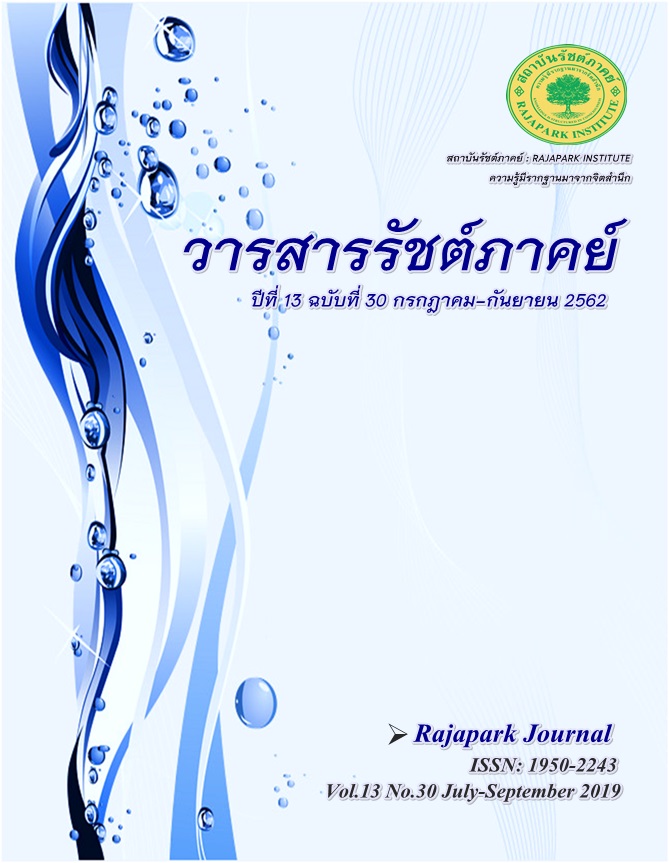การศึกษาความสัมพันธ์ระหว่างทุนทางปัญญาและการเติบโตอย่างยั่งยืนของบริษัทจดทะเบียนในตลาดหลักทรัพย์แห่งประเทศไทย
Main Article Content
บทคัดย่อ
การวิจัยครั้งนี้มีวัตถุประสงค์เพื่อศึกษาความสัมพันธ์ระหว่างทุนทางปัญญาและการเติบโตที่ยั่งยืนของบริษัทจดทะเบียนในตลาดหลักทรัพย์แห่งประเทศไทย ในปี พ.ศ. 2554 ถึง ปี พ.ศ. 2558 ได้ทำการวิจัยเฉพาะ 3 อุตสาหกรรม คือ อุตสาหกรรมบริการ อุตสาหกรรมเทคโนโลยี และอุตสาหกรรมเกษตรและอาหาร ซึ่งมีจำนวนกลุ่มตัวอย่าง 139 บริษัท โดยเก็บข้อมูลทุติยภูมิ จากงบการเงิน รายงานประจำปี และแบบแสดงรายการข้อมูลประจำปี ผู้วิจัยได้เลือกใช้วิธีในการวัดมูลค่าทุนทางปัญญาด้วยวิธี VAIC และหาอัตราการเติบโตอย่างยั่งยืนด้วยวิธีอัตราการเติบโตอย่างยั่งยืน (Sustainable growth rate (SGR)) เพื่อนำข้อมูลมาวิเคราะห์ทางสถิติเชิงพรรณนาและวิเคราะห์ความถดถอยเชิงพหุคูณ ในการวิจัยครั้งนี้ พบว่า มูลค่าทุนทางปัญญามีความสัมพันธ์เชิงบวกอย่างมีนัยสำคัญทางสถิติกับอัตราการเติบโตอย่างยั่งยืน และเมื่อวิเคราะห์องค์ประกอบของมูลค่าทุนทางปัญญาแล้ว พบว่า แต่ละองค์ประกอบมีความสัมพันธ์ต่ออัตราการเติบโตอย่างยั่งยืนแตกต่างกัน ซึ่งทุนมนุษย์ที่มีสัดส่วนมากที่สุด มีความสัมพันธ์เชิงบวกอย่างมีนัยสำคัญทางสถิติกับอัตราการเติบโตอย่างยั่งยืน ในขณะที่ทุนโครงสร้าง และทุนกายภาพ ไม่พบความสัมพันธ์กับอัตราการเติบโตอย่างยั่งยืน ข้อเสนอแนะในการวิจัยครั้งนี้ ผู้บริหารควรให้ความสำคัญในเรื่องของการลงทุนทุนทางปัญญามากขึ้น ซึ่งพบว่าทุนมนุษย์มีความสัมพันธ์ในทิศทางเดียวกับอัตราการเติบโตอย่างยั่งยืน แต่ทั้งนี้ต้องทำการศึกษาเกี่ยวกับทุนทางปัญญาและการเติบโตอย่างยั่งยืนอย่างดี เพื่อสามารถลงทุนและได้เปรียบในการแข่งขันทางธุรกิจ ขณะเดียวกันการเปิดเผยข้อมูลเกี่ยวกับทุนทางปัญญายังน้อย ผู้บริหารควรส่งเสริมมากขึ้นเพื่อเป็นประโยชน์ต่อนักลงทุน
Article Details
ทัศนะและความคิดเห็นที่ปรากฏในวารสาร ถือเป็นความรับผิดชอบของผู้เขียนบทความนั้น และไม่ถือเป็นทัศนะและความรับผิดชอบของกองบรรณาธิการ
References
1(4): 206-240.
Daily, Catherine M., & Dollinger, Marc J. (1992). An empirical examination of ownership structure in family
andprofessionally managed firms. Family Business Review, 5(2), 117-136.
Deasy, A. (2016). Intellectual Capital and Sustainable Growth in Small and Medium Enterprises in Indonesia.
OIDA International Journal of Sustainable Development, 9(10), 41-45.
Doanaldson, G. (1984). Managing Corporate Wealth: The Operation of a Comprehensive Financial Goals System.
New York: Praeger.
Dupont. (2007). Sustainable Growth (Online). Retrieved March 15, 2016, from http//www2.dupont.com
Edvinsson, L., & Malone, M. (1997). Intellectual Capital. Harper Business, New York.
Higgins, R. C. (1992). Analysis for financial management. (3rd ed.), Business One Irwin: Homewood, IL.
Kaplan, R. S., Norton, D. P. (1992). The Balanced Scorecard: Measures that Drive Performance.
Harvard Business Review, (January-February): 71-79.
Morris, D., & J. K. Eric Press. (2008). Profitability, Growth, Conservatism, and the Reliability of Accounting
Numbers, Department of Finance St. Josephs, University of Philadelphia.
Pamela, P. D. (2005). Sustainable growth. Retrieved March 11, 2016, from
educ.jmu.edu/~drakepp/FIN362/resources/sgr.pdf
Pulic, A. (2004). An Accounting Tool for IC Management (Online). Retrieved March 11, 2016, from
http://www.vaic.net
Roos, G., & Roos, J. (1997). Measuring your company’s intellectual capital performance. Long range planning
30(3): 413-426.
Shui-ying, J., & Ying-yu, W. (2008). The Contribution of Intellectual capital to firms' sustainable growth ability:
An empirical investigation based on listed companies in china. Journal: 2008 International Conference on Information Management, Innovation Management and Industrial Engineering, 1, 394-397.
Stewart, T. (1997). Intellectual Capital the new wealth of organization. London: Nicholas Berkley.
Sveiby, K. E. (1997). The new organizational wealth. Eerrett-Koehler Publisher, Inc: San Francisso, USA.
Teece, D. J. (2000). Strategies for managing knowledge assets: the role of firm structure and industrial context.
Long Range Planning, 33(1), 35-54.
Tobin, James & Brainard, William C. (1997). Asset Markets and the Cost of Capital, Economic Progress,
Private Values and Public Policy: Essays in Honor of William Fellner, edited by Belassa B., &
Nelson R., Amsterdam: North Holland.
Wahyuni, N. I., & Dino, N. V. (2016). Determinant Of The Sustainable Growth Rate. Faculty of economic and
business, University of Jember.
Wiig, K. M. (1997). Knowledge Management: An Introduction and Perspective. Journal of Knowledge
Management, 1(1), 6-14.

